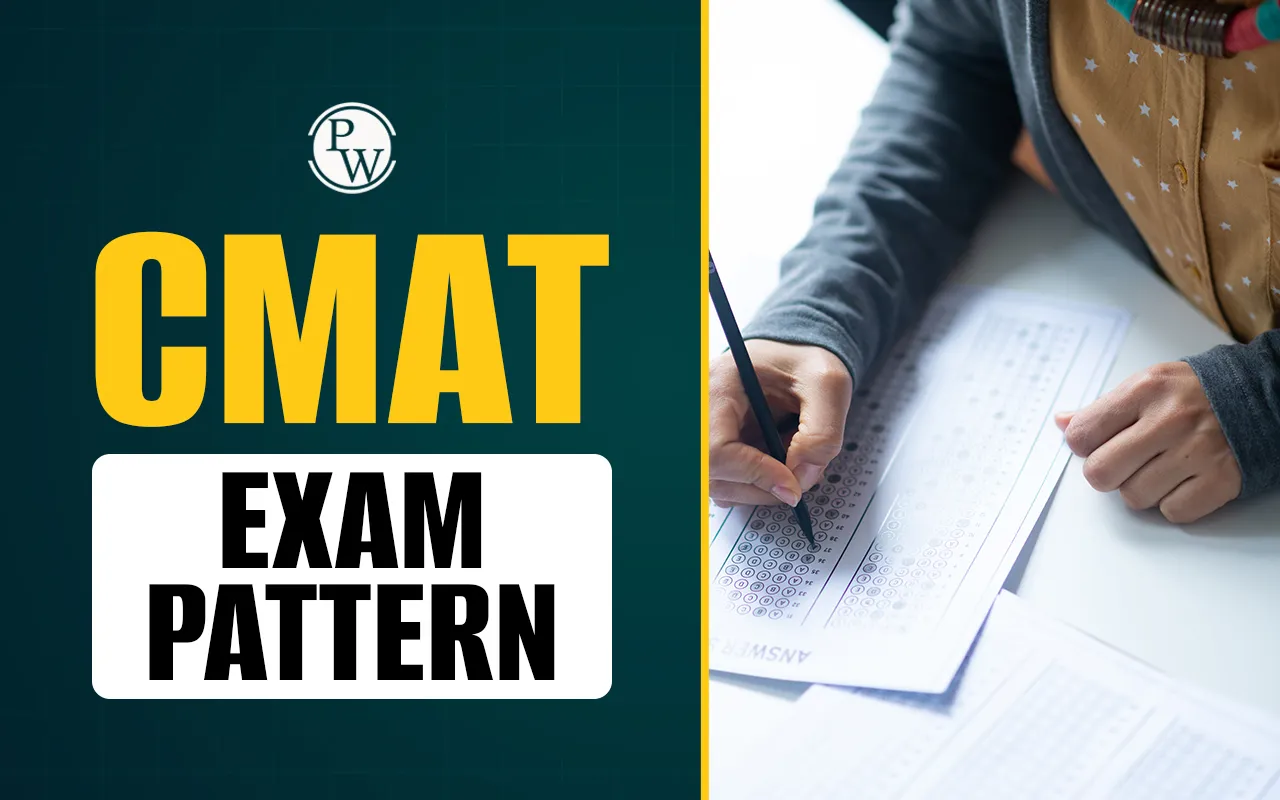

CMAT Exam Pattern: The Common Management Admission Test (CMAT) is an important entrance exam for candidates to get admission into the MBA and PGDM courses in India. It is conducted every year by the National Testing Agency (NTA).
Understanding the CMAT exam pattern is very important for all candidates to create a proper study plan, manage time, and improve accuracy during the exam. The CMAT exam pattern provides details regarding the question types, marking scheme, and time duration of the exam.
CMAT Exam Pattern Overview
CMAT exam pattern is designed to evaluate a test taker’s logical thinking, language ability, general awareness, and understanding of business concepts. The exam is conducted online in Computer-Based Test (CBT) mode at the designated test centres. There are five sections in the CMAT paper, including:
-
Quantitative Techniques and Data Interpretation
-
Logical Reasoning
-
Language Comprehension
-
General Awareness
-
Innovation and Entrepreneurship
Each section contains 20 questions, making a total of 100 questions in the entire exam. Every question carries 4 marks for a total of 400 marks. The duration of the exam is 3 hours, and there is no sectional time limit.
Section Wise CMAT Exam Pattern 2026
CMAT is an important MBA entrance exam conducted by the NTA every year. It provides admission to candidates in various MBA and PGDM courses. The question paper consists of 100 objective-type multiple-choice questions (MCQs). Each question has five options, and students must choose the correct one. A section-wise structure of the CMAT Exam Pattern is provided in the table below:
| CMAT Exam Pattern 2026 | ||
| Sections | Number of Questions | Maximum Marks |
| Quantitative Techniques & Data Interpretation | 20 | 80 |
| Logical Reasoning | 20 | 80 |
| Language Comprehension | 20 | 80 |
| General Awareness | 20 | 80 |
| Innovation & Entrepreneurship | 20 | 80 |
| Total | 100 | 400 |
Innovation and Entrepreneurship section was introduced as an optional section in 2021, but later became mandatory from 2022 onwards. This section tests students’ understanding of creative ideas, problem-solving skills, and business innovation. The CMAT exam pattern has been updated a few times in the past years. Earlier, there were 25 questions in each section, but now it has been reduced to 20. The exam duration has also been set at 3 hours for all candidates.
CMAT Marks vs Percentile
In the CMAT exam, under the CMAT Exam Pattern, the marks scored by a student are converted into a percentile. The percentile provides details regarding a candidate’s position compared to other candidates. A higher percentile means a better rank in the exam.
The CMAT percentile is not the same as marks. It depends on the number of students who have appeared for the exam and their performance. The following table gives an approximate idea of CMAT marks vs percentile:
| CMAT Marks vs Percentile | |
| CMAT Score Range | Approximate Percentile |
| 310 – 350 | 99 – 100 percentile |
| 280 – 310 | 95 – 99 percentile |
| 240 – 280 | 85 – 95 percentile |
| 200 – 240 | 70 – 85 percentile |
| Below 200 | Below 70 percentile |
Candidates looking to join top business schools like JBIMS, SIMSREE, KJ Somaiya, or Great Lakes Institute of Management will require a CMAT percentile above 95. Percentile can be improved by attempting around 75–80 questions accurately. Since there is negative marking, it is better to avoid guessing.
CMAT Exam Pattern for MBA
CMAT exam pattern for MBA admissions is designed to test skills that are important for business management and leadership. Each section checks a different ability:
-
Quantitative Techniques and Data Interpretation: This section measures mathematical and numerical skills. Topics include arithmetic, algebra, geometry, percentages, time and work, profit and loss, ratios, and data interpretation from tables, charts, and graphs.
-
Logical Reasoning: This part checks problem-solving and reasoning ability. It includes puzzles, arrangements, analogies, coding-decoding, blood relations, direction sense, and logical series.
-
Language Comprehension: It tests English reading and grammar skills. There are reading comprehension passages, synonyms, antonyms, fill-in-the-blanks, and sentence correction questions.
-
General Awareness: This section asks questions about current affairs, Indian economy, sports, geography, politics, and world events. Reading newspapers regularly helps improve performance here.
-
Innovation and Entrepreneurship: It focuses on creative ideas, business models, and start-up knowledge. Students are asked about basic business concepts, famous entrepreneurs, and innovative practices in companies.
CMAT Exam Time
The total time for the CMAT exam is 3 hours (180 minutes). There is no sectional time limit, so candidates can manage effectively. Some of the simple time management tips for the CMAT exam are as follows:
-
Spend around 30–35 minutes on each section.
-
Start with the section you are most confident about.
-
Save the last 10–15 minutes to review answers.
-
Avoid spending too much time on difficult questions. Skip and come back later if possible.
Since there is negative marking, it is better to attempt questions only when you are sure of the answer. Time management plays a big role in achieving a high percentile.
Join PW MBA Online Coaching to start strategic preparation for CAT, XAT, GMAT, and more. PW MBA Coaching Class offers regular guidance to help candidates strengthen their fundamentals and improve problem-solving skills by providing updated study resources.
